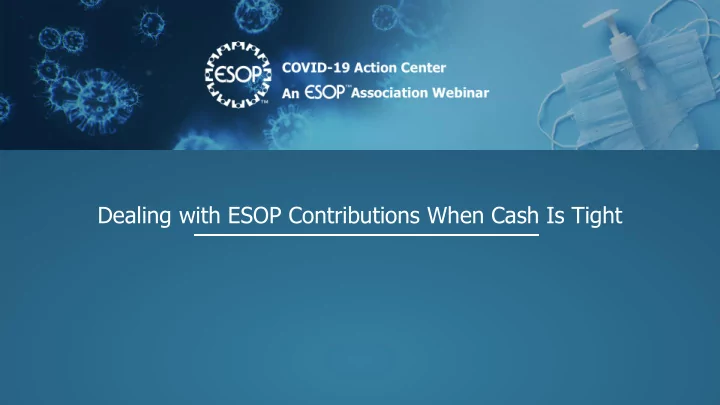

Dealing with ESOP Contributions When Cash Is Tight
Dolores Lawrence Avery Chenin Ted Margarit Managing Director Shareholder Managing Director Blue Ridge ESOP Associates SES ESOP Strategies Chartwell
Agenda • Who is Still an Employee? • Distribution Policies and Managing Payouts • Balancing Competing Needs for Cash • Other Sources of Cash
Who is Still an Employee? • Terminations, workforce shrinkage potentially impact distribution timing and future repurchase obligations • Layoffs, furloughs, leaves of absence – who is still an employee and who has experienced a severance from employment? • Facts and circumstances test • Still paid? • Health insurance, other benefits in place? • Company email still working? • The longer unpaid and gone – the more likely there has been a severance from employment
Distribution Policies and Managing Payouts • Check your plan document and distribution policy – possible changes in form or method may be possible when the goal is to conserve cash • Change large payouts from lump sum to installments • Convert small balance lump sum to installments • Change minimum dollar amount of an installment • Eliminate small balance force outs • Distribute shares subject to a put option instead of a cash contribution if there are willing buyers for the shares redeemed by the Company • Worst case – distribute shares in exchange for a promissory note – collateral and other rules apply
Distribution Policies and Managing Payouts • Your plan document and distribution policy – change timing ? • Need to consider current Plan and Distribution policy language and confirm how long commencement of distribution elections can be delayed: • “As soon as administratively feasible” or “no later than” language may provide room for delay • If necessary and warranted, commence payment after an interim valuation and updating of participant accounts • Fiduciary and other concerns – consult legal counsel
Distribution Policies and Managing Payouts • Dealing with Diversifications • Optimal document language – the 90 day election period begins after the Employer stock fair market value is communicated to participants • Dealing with sub-optimal language – the 90 day election period begins on the first day of the plan year
Balancing Competing Needs for Cash • Business cash needs • Operating expenses Defer A/P; minimize expenses; government assistance loans • • Debt service payments/rent Refinance at lower rates/longer amortization; seek forbearance • • Capital expenditures Lease instead of buy? If 100% ESOP, no depreciation tax savings • • Net working capital Defer A/P, accelerate A/R; expand bank revolver; A/R factoring • • Growth capital (new facilities, acquisitions) Equity/subordinated debt investors are still providing resources for growth investments that provide • attractive returns
Balancing Competing Needs for Cash • ESOP cash needs • Lending financial covenants and possible impacts on ESOP funding • What comes first: Funding for ESOP seller loan repayments, or • Funding for ESOP distributions and diversifications? • What if we can’t handle both? •
Balancing Competing Needs for Cash • ESOP cash needs • Eliminate reshuffle / segregation provisions so that funding for segregation is not just another draw on cash • While these provisions are rare in ESOPs, hardship or participant loan provisions can be eliminated by amendment • If funding matching contributions in the ESOP, consider temporary match suspension • If there is cash in the ESOP, use it to pay plan operating expenses (if permitted by the plan) • Consider elective transfers of 401(k) funds to the ESOP to purchase company stock
Other Sources of Cash – Debt Capital Solutions • New or expanded debt financing facilities Government assistance loans • Economic Injury Disaster Loan Program ($2m limit, $10k grant) • Paycheck Protection Program ($10m limit, maybe forgivable) • Title IV loans for large and mid-size businesses • Bank lenders • Increase revolver limit, seek new term loans (expect fully asset collateralized) • Non-bank lenders • Unitranche, 2 nd lien, mezzanine loans, etc. are available for more mature businesses ($5+ million of • EBITDA) Sale leaseback transactions • For asset intensive businesses (rolling stock, real estate, etc.) •
Other Sources of Cash – Equity Capital Solutions • Equity investments from former owner(s), employees, management, 3 rd parties (private equity, key customer/supplier, etc.)? 100% ESOPs looking to maintain tax exempt status • Structured equity (a deeply subordinated loan with warrants) – either former owner(s) or 3 rd parties • Employer/employee contributed 401(k) assets rolled over into ESOP and reinvested into newly issued • shares at employer / participant option – many caveats and considerations apply! Partially ESOP-owned companies or 100% ESOPs willing to forego tax exemption • “Drop - down LLC” structures to maintain passthrough ESOP tax benefit and avoid S corp pro rata • distributions (if applicable) Allows direct equity investments and more flexibility •
Thank You Avery Chenin, Dolores Lawrence, and Ted Margarit amch@stevenslee.com dlawrence@BlueRidgeESOP.com ted.margarit@chartwellfa.com
Recommend
More recommend